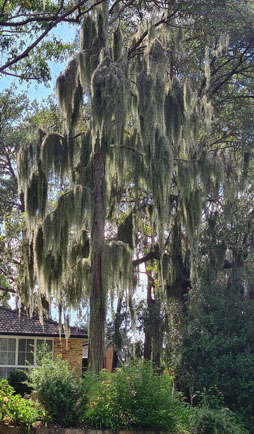 In recent years STEP has become increasingly concerned about the proliferation of Spanish Moss on our local trees and its potential impact on our bushland. So in December 2023 we asked members to send us details of any Spanish Moss they have seen growing on trees. We then undertook a preliminary survey from Cowan to Marrickville to determine what tree species it grew on. What we found horrified us.
In recent years STEP has become increasingly concerned about the proliferation of Spanish Moss on our local trees and its potential impact on our bushland. So in December 2023 we asked members to send us details of any Spanish Moss they have seen growing on trees. We then undertook a preliminary survey from Cowan to Marrickville to determine what tree species it grew on. What we found horrified us.
Trees most affected by Spanish Moss
Turpentine (Syncarpia glomulifera) is the most severely affected of all the 76+ species of plants we recorded Spanish Moss growing in. Infestations can be so dense and widespread that whole trees are festooned. Spanish Moss flourishes over Turpentine leaves and worryingly it appears it may be able to kill mature trees by preventing photosynthesis. Locally, Turpentines are important trees in the critically endangered Sydney Turpentine-Ironbark Forest and Blue Gum High Forest as well as in sandstone gullies. Their loss would be disastrous. Worse still, Turpentines are common trees in fertile forests from the Queensland border to near Ulladulla and our evidence suggests that Spanish Moss could damage Turpentines all the way along the coast and ranges. We are not sure why it flourishes so well on Turpentines but we are prepared to speculate that leachates from the fungi on the leaves encourages its growth.
More bad news for our rainforests and wet sclerophyll forests is that Lilly Pilly (Acmena smithii), Cheese Tree (Glochidion ferdinandi) and Brush Box (Lophostemon confertus), all major components of our east coast rainforest, can be severely affected while Coachwood (Ceratopetalum apetalum) and Blueberry Ash (Elaeocarpus reticulatus) can certainly carry Spanish Moss. In addition to causing damaged or dead trees, threats to ecosystems include subtle effects such as altered water and nutrient cycles, changed predator/prey interactions, habitat alteration, moderation of the microclimate and transformed fire regimes. Changes such as these are some of the greatest conservation threats to biodiversity in Australia.
The good news is that eucalypts, bloodwoods and Sydney Red Gum (Angophora costata) seem to be resistant to it. We only repeatedly recorded Spanish Moss flourishing on Red Mahogany (Eucalyptus resinifera).
How it spreads
Spanish Moss is obviously well loved by many gardeners, but STEP is not sure that gardeners realise how rapidly it can grow and spread. What today may be a gentle grey ornamental addition to the garden may overwhelm it with dense heavy screens of moss up to 3 m long over a few years. Overseas, festoons over 8 m long have been recorded. The artistic addition to the garden today may be a nightmare tomorrow. You may think that your garden is safely distant from bushland, but we recorded a jump of 70 m from the nearest Spanish Moss when it was used by Noisy Miners in their nest. All gardens must therefore be viewed as sources of bushland infestations.
Spanish Moss can spread in several ways. Asexual spread can occur with the tip of plants blowing in the wind and becoming entangled in other parts of the plant or a different plant. Birds are obvious dispersers as they move Spanish Moss for nest construction.
Physical control will be difficult as it is an air plant and has no contact with the ground. In most cases we found it out of reach, sometimes 15 m up a tree. We haven’t trialled chemical control methods used in the USA, but they are listed in our report.
Recommendations
- Gardeners remove all moss they can reach, put it in their green bin and prevent spread.
- Local authorities such as local councils and NPWS remove it from all public places, including trees on nature strips.
- Add Spanish Moss to the next iteration of the Greater Sydney Regional Strategic Weed Management Plan and all other relevant regional strategic weed management plans.
- Classify Spanish Moss at a level that enables its eradication and containment, prohibition of sale and distribution, e.g. as a regional priority weed.
- Undertake research into why Turpentines are a favoured host and the ecological effects of Spanish Moss on bushland.
- Undertake research into control methods.
Swaying veils of grey in dead or dying trees and simplified bushland is not something to look forward to. Let’s not risk it.
Read our full report or check out our website.













